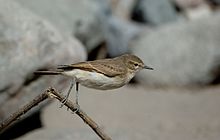The ground tyrants (Muscisaxicola) are a genus of passerine birds belonging to the tyrant flycatcher family Tyrannidae. There are about 13 different species. They are ground-dwelling birds which inhabit open country in South America, particularly the Andes and Patagonia. Several southern species are migratory, moving northward for the winter. Ground tyrants feed on insects and other invertebrates, mainly by picking them from the ground.
| Ground tyrants | |
|---|---|

| |
| Spot-billed ground tyrant (Muscisaxicola maculirostris) | |
| Scientific classification | |
| Domain: | Eukaryota |
| Kingdom: | Animalia |
| Phylum: | Chordata |
| Class: | Aves |
| Order: | Passeriformes |
| Family: | Tyrannidae |
| Genus: | Muscisaxicola d'Orbigny & Lafresnaye, 1837 |
| Type species | |
| Muscisaxicola rufivertex[1] d'Orbigny & Lafresnaye, 1837
| |
A flight display is performed during the breeding season. The nest is a cup of twigs or grass which, in most species, is built in a burrow, crevice or under rocks.
Ground tyrants are fairly small (13–20 cm in length) with longish legs, a slender bill and an erect posture. The plumage is dull and mainly grey or brown with paler underparts. The head is variably patterned with several species having rufous patches on the crown or white between the bill and eye. The birds have simple calls and are often silent.
Systematics and taxonomy
editA study of mitochondrial DNA by Chesser (2000) has shown that the little ground tyrant (M. fluviatilis) is highly divergent and not closely related to the other ground tyrants. All the remaining species are related and form a monophyletic group, although the spot-billed ground tyrant (M. maculirostris) is somewhat divergent from the others. The little and spot-billed ground tyrants are smaller and browner than the other species and the little ground tyrant also differs in its habitat, occurring near rivers in the Amazon rainforest.[2]
The paramo ground tyrant (M. alpinus) and Taczanowski's ground tyrant (M. griseus) were previously treated as a single species but are genetically divergent with the paramo ground tyrant belonging to a southern Andean and Patagonian clade within the genus and Taczanowski's ground tyrant belonging to a central Andean clade.[2] The name plain-capped ground tyrant is used by some authors to refer to M. griseus with paramo ground tyrant used for M. alpinus.
The genus name Muscisaxicola is masculine, therefore the species names griseus, cinereus, maclovianus, alpinus and capistratus are correct rather than grisea, cinerea, macloviana, alpina and capistrata. The names flavinucha and albilora are invariable.[3]
Species list
editThe genus contains 12 species:[4]
- Spot-billed ground tyrant, Muscisaxicola maculirostris
- White-fronted ground tyrant, Muscisaxicola albifrons
- Ochre-naped ground tyrant, Muscisaxicola flavinucha
- Paramo ground tyrant, Muscisaxicola alpinus
- Taczanowski's ground tyrant, Muscisaxicola griseus
- Cinereous ground tyrant, Muscisaxicola cinereus
- Rufous-naped ground tyrant, Muscisaxicola rufivertex
- Dark-faced ground tyrant, Muscisaxicola maclovianus
- White-browed ground tyrant, Muscisaxicola albilora
- Cinnamon-bellied ground tyrant, Muscisaxicola capistratus
- Puna ground tyrant, Muscisaxicola juninensis
- Black-fronted ground tyrant, Muscisaxicola frontalis
The little ground tyrant was formerly placed in Muscisaxicola but was moved to the monotypic genus Syrtidicola following the publication of a phylogenetic study in 2020.[4][5]
References
edit- ^ "Tyrannidae". aviansystematics.org. The Trust for Avian Systematics. Retrieved 2023-07-16.
- ^ a b Chesser, R. Terry (2000). "Evolution in the High Andes: the Phylogenetics of Muscisaxicola Ground-Tyrants" (PDF). Molecular Phylogenetics and Evolution. 15 (3): 369–380. CiteSeerX 10.1.1.533.7935. doi:10.1006/mpev.1999.0774. PMID 10860646. Archived from the original (PDF) on 2007-06-09. Retrieved 2007-07-17.
- ^ South American Classification Committee (2007) A classification of the bird species of South America, part 8 Archived 2007-06-25 at the Wayback Machine. citing David N. & Gosselin M. (2002). "The grammatical gender of avian genera". Bulletin of the British Ornithologists' Club. 122: 257–282.
- ^ a b Gill, Frank; Donsker, David; Rasmussen, Pamela, eds. (July 2021). "Tyrant flycatchers". IOC World Bird List Version 11.2. International Ornithologists' Union. Retrieved 25 July 2021.
- ^ Chesser, R.T.; Harvey, M.H.; Brumfield, R.T.; Derryberry, E.P. (2020). "A revised classification of the Xolmiini (Aves: Tyrannidae: Fluvicolinae), including a new genus for Muscisaxicola fluviatilis". Proceedings of the Biological Society of Washington. 133 (1): 35–48. doi:10.2988/20-00005.
Further reading
edit- Jaramillo, Alvaro; Burke, Peter & Beadle, David (2003) Field Guide to the Birds of Chile, Christopher Helm, London
- Vuilleumier, François (1994) Nesting, behavior, distribution and speciation of Patagonian and Andean ground tyrants (Myiotheretes, Xolmis, Neoxolmis, Agriornis and Muscisaxicola), Ornitologia Neotropical, 5: 1–55
External links
editVideo, spottings and photos on Birds of the world.
- Muscisaxicola albifrons—Videos and Photos
- Muscisaxicola albilora—Videos and Photos
- Muscisaxicola alpinus—Videos and Photos
- Muscisaxicola capistratus—Videos and Photos
- Muscisaxicola cinereus—Videos and Photos
- Muscisaxicola flavinucha—Videos and Photos
- Muscisaxicola frontalis—Videos and Photos
- Muscisaxicola griseus—Videos and Photos
- Muscisaxicola juninensis—Videos and Photos
- Muscisaxicola maclovianus—Videos and Photos
- Muscisaxicola maculirostris— Videos and Photos
- Muscisaxicola rufivertex—Videos and Photos